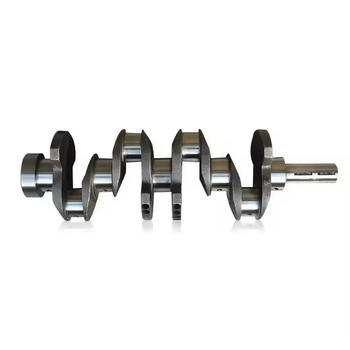
The crankshaft is the backbone of your engine, transforming the reciprocating motion of the pistons into rotational force that ultimately drives your wheels. So, how much horsepower can a crankshaft handle before it cries uncle? The answer, unfortunately, isn't a simple one-size-fits-all number. It depends on a complex interplay of factors, from the material and manufacturing process to the overall engine design and intended application.
Crankshaft Material and Manufacturing: The Foundation of Strength
The material a crankshaft is forged from plays a crucial role in its horsepower capacity. Common materials include cast iron, forged steel, and billet steel. Cast iron is generally the weakest, suitable for lower horsepower applications. Forged steel offers a significant strength upgrade, capable of handling considerably more horsepower. At the top end, billet steel, machined from a solid block of steel, provides the ultimate in strength and durability, making it ideal for high-performance engines pushing significant horsepower. The manufacturing process also matters. Forging aligns the grain structure of the metal, enhancing its strength and fatigue resistance compared to casting. So, when considering how much hp a crankshaft can handle, material and manufacturing are paramount.
Crankshaft Design: Balancing Strength and Weight
Beyond material, the design of the crankshaft itself is another critical factor. The overall size and shape, journal diameters, and the presence of counterweights all influence its strength and ability to withstand high horsepower loads. A larger, heavier crankshaft with robust journals will typically handle more horsepower than a smaller, lighter one. However, increasing weight also increases rotational inertia, which can negatively impact engine responsiveness. Therefore, engineers strive to find a balance between strength and weight, optimizing the crankshaft design for the specific horsepower target and application.
Engine Configuration and Operating Conditions: The Context Matters
The overall engine configuration and operating conditions also contribute to the stress placed on the crankshaft. Factors such as engine displacement, number of cylinders, firing order, and operating RPM all play a role. High-revving engines, for instance, place significantly greater stress on the crankshaft than low-revving ones. Similarly, engines with a higher number of cylinders distribute the load across more journals, potentially increasing the overall horsepower capacity of the crankshaft. Considering crankshaft horsepower capacity in isolation from the broader engine context can lead to inaccurate estimations and potentially catastrophic failures.
Crankshaft Failure: The Consequences of Exceeding Limits
Pushing a crankshaft beyond its horsepower limit can have devastating consequences, ranging from a simple fatigue crack to a complete catastrophic failure. Signs of an impending crankshaft failure can include unusual vibrations, knocking noises, or low oil pressure. If you suspect your crankshaft is nearing its limit, it's crucial to address the issue immediately to prevent further engine damage. Have you ever experienced a crankshaft failure? What were the symptoms?
Increasing Crankshaft Strength: Strategies for Higher Horsepower
If you're aiming for higher horsepower, several strategies can increase the crankshaft's capacity. Upgrading to a forged or billet steel crankshaft is a common approach. Other techniques include shot-peening to improve surface strength, nitriding to enhance hardness, and cryogenically treating to relieve internal stresses. These processes can significantly increase the crankshaft's horsepower capacity and improve its overall durability.
Matching Components: The Importance of a Balanced System
When increasing horsepower, it's essential to consider the entire rotating assembly, not just the crankshaft. Connecting rods, pistons, and bearings all need to be up to the task of handling the increased loads. A weak link in the chain can negate the benefits of a strong crankshaft and lead to premature failure. Ensuring all components are matched and balanced is key to achieving reliable high-horsepower performance.
Beyond Horsepower: Considering Torque and Stress
While horsepower often gets the spotlight, torque is equally important when discussing crankshaft capacity. Torque represents the twisting force applied to the crankshaft and is directly related to the pressure generated within the cylinders. High torque, especially at lower RPM, can put immense stress on the crankshaft. So, how much hp can a crankshaft handle should also be considered in light of the torque output of the engine.
Practical Considerations for Determining Crankshaft Capacity
Determining the exact horsepower capacity of a crankshaft isn't always straightforward. Manufacturers often don't publish specific horsepower ratings for crankshafts. Consulting with experienced engine builders and referencing real-world examples of similar engine builds can provide valuable insights. Ultimately, a conservative approach, prioritizing reliability over absolute horsepower, is always recommended.
Moving Forward: Building a Strong and Reliable Engine
Understanding the factors influencing crankshaft horsepower capacity empowers you to make informed decisions about your engine build. By carefully considering material, design, operating conditions, and supporting components, you can push the limits of your engine's performance while maintaining reliability and longevity. So, before chasing bigger horsepower numbers, invest time in understanding the heart of your engine—the crankshaft—and its crucial role in delivering power and performance. Remember to consult with experienced professionals for personalized advice based on your specific engine and application.

 The Unseen Powerhouse: Unveili
The Unseen Powerhouse: Unveili
 Unveiling the Precision: The A
Unveiling the Precision: The A
 Navigating the World of Cranks
Navigating the World of Cranks
 The Unsung Heroes: What Makes
The Unsung Heroes: What Makes
